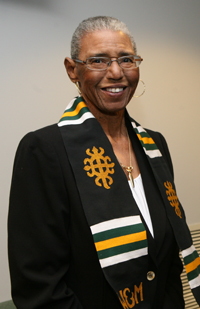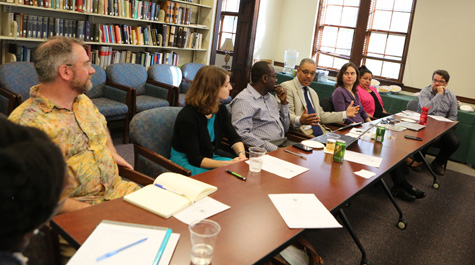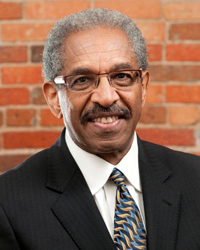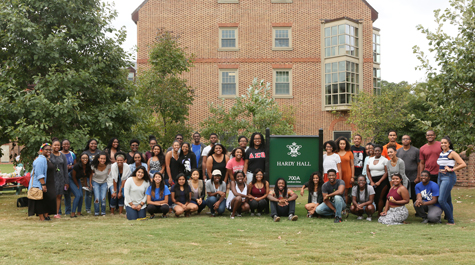Keeping up momentum: Team works to implement task force on race’s recommendations
From the front porch of her office, Chief Diversity Officer Chon Glover can see the glossy new sign for Hardy Hall clearly.
It is more than just a locational indicator for a residence hall; it’s an emblem of change at William & Mary as a result of work that was begun by the Lemon Project in 2009 to explore the College’s racial past and seek ways to do better going forward. The work was continued most recently by the Task Force on Race and Race Relations, which completed its study and report last spring.
This semester, that work remains ongoing as a newly formed implementation team takes the task force’s recommendations and develops a plan to put more of them into action.
“I want to keep the momentum up,” said Glover, who is leading the team that began meeting earlier this year to determine what actions are possible now, what are long-terms goals and which of the task force’s recommendations need further analysis.
“The task force’s work isn’t something we want to leave on the shelf,” she added. “We took immediate action last spring on several recommendations, but we want to continue to make progress and determine what we can accomplish next. These are things that are going to make us a better place, from the smallest to the largest.”
Chaired by Glover, the Task Force on Race and Race Relations was created in early 2015 by President Taylor Reveley in response to a series of race-related incidents throughout the nation and in the campus community.
The group included faculty, staff, alumni and a member of the Board of Visitors. Graduate and undergraduate students also served on both the task force and its subcommittees, which were organized around the four areas of the president’s charge: campus climate, prevention and education, recruitment of diverse faculty and senior administration, and bias reporting and incident protocol. Reveley asked the task force to provide him with a report by March 2016.
Steps taken
Soon after that report, which included a list of 51 recommendations, was delivered to Reveley, he announced several actions to be prioritized, including the renaming of the Jamestown Residence Halls to Lemon and Hardy Halls: Hardy in honor of the late Carroll Hardy, a longtime administrator at the university who worked to improve diversity, and Lemon in memory of a enslaved man owned by William & Mary in the 18th century.
The halls will be dedicated at an 11:30 a.m. ceremony on Oct. 15. The event, which will be free and open to the public, will take place in Jamestown Field.
 Reveley also prioritized $1 million over the next two years as part of an initiative to increase the diversity of W&M’s faculty. That funding was approved by the Board of Visitors in April, and Glover has been working with the implementation team and Provost Michael R. Halleran on how to best utilize it. The board also approved $100,000 to hire additional personnel in the Office of Diversity and Inclusion, and a search is underway this semester to hire a deputy chief diversity officer.
Reveley also prioritized $1 million over the next two years as part of an initiative to increase the diversity of W&M’s faculty. That funding was approved by the Board of Visitors in April, and Glover has been working with the implementation team and Provost Michael R. Halleran on how to best utilize it. The board also approved $100,000 to hire additional personnel in the Office of Diversity and Inclusion, and a search is underway this semester to hire a deputy chief diversity officer.
“With more staff and resources, it gives us the opportunity to expand our work and serve as a resource for departments and schools who are developing diversity action plans, better support affinity groups and increase the professional development opportunities on diversity and inclusion topics,” Glover said.
School diversity action plans have been uploaded to the office’s website, and the focus will now turn to administrative departments, she said.
“We want to get to a point where hopefully all faculty and staff are invested in promoting the university’s diversity plans and are holding themselves and their staffs accountable for issues of diversity and inclusion,” said Glover.
Responding to campus concerns
William & Mary is one among many colleges and universities nationwide that are taking a closer look at race relations on their campuses.
According to a January 2016 survey of college and university presidents conducted by the American Council on Education’s Center for Policy Research and Strategy, 55 percent of respondents at four-year institutions said that racial climate has become more of a priority than it was three years ago.
As part of its work, the William & Mary task force sought input from the university community by holding six on-campus climate forums for students, faculty and staff and soliciting feedback through its website. The task force also worked closely with human resources to coordinate a campus climate survey the university sent to all W&M employees in September 2015.
Those survey results, which were released to campus last spring, echoed what the task force heard in other venues. Overall, African-American employees generally did not respond as favorably as the overall employee population. For example, 9 percent of African-American employees responded that they would not rate William & Mary as a good place to work, whereas only 6 percent of all employees responded the same way. In a separate question, 15 percent of African-American employees responded that they do not feel that they are treated with respect, compared to 8 percent for all employees. Among African-American faculty members, 64 percent disagreed with the statement, “At W&M, employees are treated fairly without regard to race, color or national origin.” Seventy-three percent of African-American faculty, however, said they were proud to work at William & Mary.
“Throughout this process, we heard the message that William & Mary has work to do to improve the campus climate for our African American employees,” said Reveley. “We are committed to doing so. We announced a number of immediate actions last spring, and there has been progress since this survey was given a year ago, but this work is ongoing.”
 As part of the actions announced last spring, Reveley prioritized the hiring of an external consultant to help the university better understand the concerns of black employees. That consultant, Amediate LLC, has been hired and recently began a series of 10 focus groups with employees in facilities management. Once those are done, the consultant will have 30 days to present a report to Glover and Van Dobson, associate vice president for facilities management. The findings will be incorporated into the plans being created by the implementation team, said Glover.
As part of the actions announced last spring, Reveley prioritized the hiring of an external consultant to help the university better understand the concerns of black employees. That consultant, Amediate LLC, has been hired and recently began a series of 10 focus groups with employees in facilities management. Once those are done, the consultant will have 30 days to present a report to Glover and Van Dobson, associate vice president for facilities management. The findings will be incorporated into the plans being created by the implementation team, said Glover.
“This information in tandem with what we heard during the campus fora informed our work as we created our recommendations,” said Glover, “specifically, the decision to recommend an outside vendor to facilitate focus groups with facilities management. We required additional information before making any major decisions based on the survey data. The facilitator's report will be very helpful because the focus groups involved all members of the facilities team — managers, supervisors and team members.”
Implementation and beyond
The implementation team itself was one of the action items that Reveley prioritized on recommendation from the task force. The team includes faculty, administrators and two students — people who, through their positions, have agency in getting the recommendations accomplished, said Glover. There is also engagement from the Board of Visitors. Kendrick Ashton ’98 served on the task force while a member of the board, and Lisa Roday is currently serving as the board’s liaison to the implementation team.
The team has already met twice since the beginning of September and created prioritized lists of what should be accomplished next. For the next meeting in October, the team’s members have been tasked with organizing those into short-, mid- and long-range goals.
Among the recommendations the team is looking to implement are strengthening practices for considering diversity in hiring, training and assessment of campus climate, as well as implementing mandatory diversity training for faculty and staff and expanded training for students.
In the meantime, the Office of Diversity and Inclusion is working to increase the number of professional development opportunities available to the campus community, something the task force found was needed.
 As part of that, the university’s inaugural diversity symposium — “William & Mary: Building and Sustaining an Inclusive Community”— will be held on Oct. 22 at 9 a.m. in the W&M School of Education. The event, open to faculty and staff, will include a keynote on “Implicit Bias in the Academy” by Benjamin Reese, vice president of the Office of Institutional Equity at Duke University Health System and a licensed clinical psychologist. The event will also include workshops on topics from belonging to understanding gender and gender expression. The symposium is free, but attendees must register by Oct. 10 online.
As part of that, the university’s inaugural diversity symposium — “William & Mary: Building and Sustaining an Inclusive Community”— will be held on Oct. 22 at 9 a.m. in the W&M School of Education. The event, open to faculty and staff, will include a keynote on “Implicit Bias in the Academy” by Benjamin Reese, vice president of the Office of Institutional Equity at Duke University Health System and a licensed clinical psychologist. The event will also include workshops on topics from belonging to understanding gender and gender expression. The symposium is free, but attendees must register by Oct. 10 online.
The Lemon Project has held annual symposiums, open to members of the campus and local communities, each spring since 2010. This year’s Lemon Project symposium, organized around the theme of “Jim Crow and Civil Rights in the Age of President Obama,” was held in February and included a keynote address by civil rights pioneer Diane Nash.
Next spring, a Diversity & Inclusion Committee will be formed to take the place of the diversity and equal opportunity committees, upon recommendation from the task force. The new committee will absorb the goals of the two committees it is superseding, and it will continue the work of the implementation team when it concludes its efforts at a to-be-determined date. The committee will also create a five-year diversity and inclusion plan for the university, which will address not only race but other aspects of diversity, as well, said Glover.
As the implementation team prepares to keep the momentum started by the task force going, Glover said she is feeling positive about the steps that have been taken thus far.
“I think they have invigorated our faculty, students, staff and alums and community members, too,” she said, adding that renaming the residence halls and committing $1 million to faculty diversity were significant first steps.



